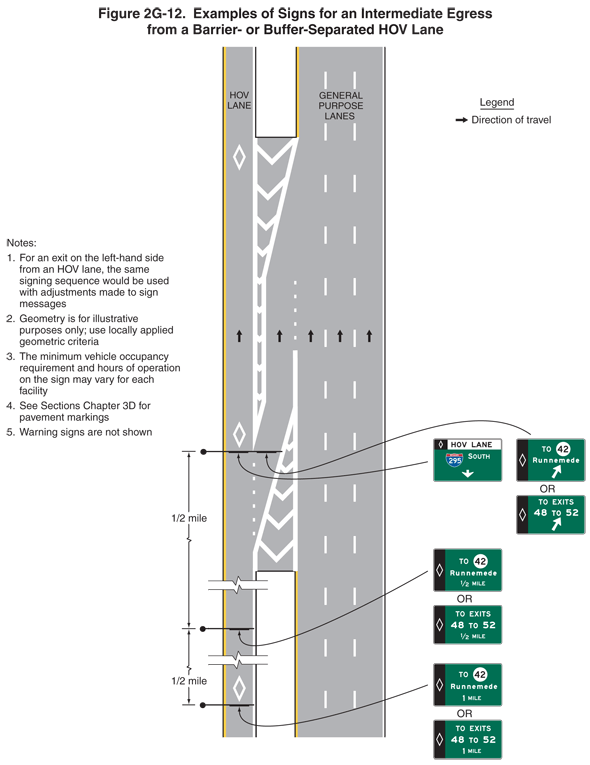2009 Edition Part 2 Figure 2G-12. Examples of Signs for an Intermediate Egress from a Barrier- or Buffer-Separated HOV Lane

Figure 2G-12. Examples of Signs for an Intermediate Egress from a Barrier- or Buffer-Separated HOV Lane
This figure shows examples of signs for an intermediate egress from a barrier- or buffer-separated HOV lane.
A legend shows a black arrow indicating the direction of travel on the highway.
The figure shows a vertical highway as a divided highway with one HOV lane to the left of a buffer or barrier to the left of three general purpose lanes. Broken white lines separate the general purpose lanes from each other. White HOV diamond symbols are shown marked on the pavement of the HOV lane.
One-third from the bottom of the figure, a theoretical gore is shown extending from the barrier or buffer toward the north. It is shown composed of a white triangle formed by white channeling lines and white chevron markings, angling to the right. The theoretical gore is shown separating the HOV lane from an exit lane that angles from the HOV lane to the left general purpose lane. The exit lane continues north and is separated from the left general purpose lane by a dotted white line extending from the north end of the theoretical gore. It then is shown tapering to the right and into the left general purpose lane by the angle of a second theoretical gore shown extending from the southern end of a barrier or buffer at the top of the figure. This theoretical gore is shown separating the HOV lane from the general purpose lanes. It is shown angling to the left and extending as a long narrow taper between the exit lane and HOV lane.
At the top of the figure, the exit lane has disappeared and the one HOV lane is shown to the left of a barrier or buffer to the left of the three general purpose lanes.
Four signs and sign assemblies are shown mounted over the HOV lane:
- At the bottom of the figure, at a dimensioned distance of ½ mile prior to the second sign, the first sign is shown as a horizontal rectangular green sign with a white border and legend. A white diamond outline symbol on a black panel is shown on the left third of the sign. This panel is shown to the left of the word "TO" to the left of the black numeral "42" on a white disk on the top line, the word "Runnemede" on the middle line, and the words "1 MILE" on the bottom line. Below this sign, the word "OR" is shown and another sign. This sign is shown as identical to the first sign except the words "TO EXITS 48 TO 52" are shown on the top two lines instead of the route 42 legend and the word "Runnemede."
- The second sign is shown at a dimensioned distance of ½ mile prior to the third sign. It is shown as identical to the first sign except the words "1/2 MILE" are shown instead of the words "1 MILE." Below this sign, the word "OR" is shown and another sign. It is shown as identical to the alternate first sign except the words "1/2 MILE" are shown instead of the words "1 MILE."
- The third and fourth signs are shown in a horizontal array mounted over the HOV lane and the exit lane from the HOV lane to the general purpose lanes, respectively. They are shown at the point of theoretical gore that extends down from the barrier or buffer at the top of the figure. A dotted white line is shown across the exit lane and ending at the gore. The third sign is shown as a horizontal rectangular green sign with a white border and legend. The top portion of the sign is shown as a white panel with a white diamond outline symbol on a vertical rectangular black panel to the left of the words "HOV LANE" in black. This panel is shown above a red and blue Interstate shield for I-295 to the left of the word "SOUTH" centered on the top line above a short downward-pointing vertical arrow. The fourth sign is shown as identical to the first sign except a short diagonal arrow pointing up and to the right is shown instead of the words "1 MILE." Below this sign, the word "OR" is shown and another sign. It is shown as identical to the first alternate sign except short diagonal arrow pointing up and to the right is shown instead of the words "1 MILE."
The following notes are included:
- For an exit to an HOV lane on the left-hand side from an HOV lane, the same signing sequence would be used with adjustments made to sign messages.
- Geometry is for illustrative purposes only. Use locally applied geometric criteria.
- The minimum vehicle occupancy requirement and hours of operation on the sign may vary for each facility.
- See Chapter 3D for pavement markings.
- Warning signs are not shown.
